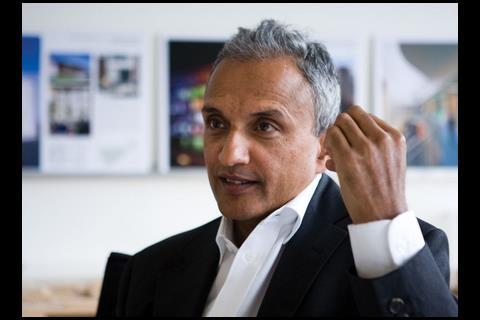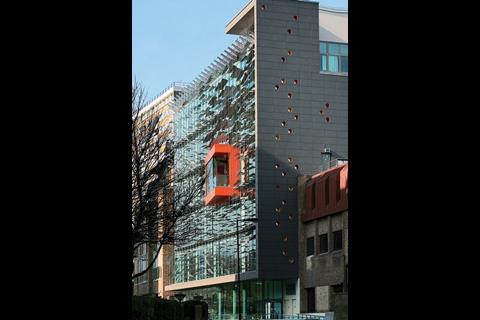Politician and academic â not to mention architect â the new RIBA president certainly has the CV to tackle the top post in British architecture. But does he have the policies?
Trim in physique, dapper in dark suit and brilliant white shirt, and with his hands communicating as expressively as his mouth, Sunand Prasad chats away in his practiceâs office at the fringes of the City of London.
Whether itâs about statement buildings, design-and-build contracts or the RIBAâs grapples with the government, he lets flow a stream of insights with the easy manner of a skilled politician. Which is precisely what he is: the Indian-born architect has been a Cabe commissioner for seven years and RIBA vice-president for policy and strategy for three. Indeed, Prasad has been RIBA president in waiting for so long that he can be viewed as the Gordon Brown of the architectural fraternity.
Like Brown, Prasad will be quick to set out his vision for the organisation when he finally takes over from the incumbent, Jack Pringle, next week. And, so far, that vision sounds fairly radical: âI think that, rather than as a professional group, we need to see ourselves as knowledge communities,â he says. âWe are trying to foster specialist groups of interest within the RIBA covering sustainability, housing, procurement and conservation, for example.
âPeople get very enthusiastic when talking about their subject and the best service the RIBA as an institution can provide is to enable that knowledge transfer through these specialist groups.â
Prasad comes across as the thinking manâs architect, combining those political skills with a deep-thinking, academic air and talent as a designer. On the architectural front, the specialist hospitals, health centres, schools and sheltered housing produced by his 29-year-old practice, Penoyre & Prasad, are regular winners of top design awards. Academically, he has a PhD based on research into Indian courtyard housing, traditional and modern.
And politically, his heritage stretches back way beyond his time at Cabe. âI grew up in the middle of India in a Gandhian community. Thatâs because both my parents were involved in the independence struggle. So the house was full of political discussion and that does trickle into your brain. In particular, the idea that you should be useful was very strong.â
These days, Prasad the politician is focused on discussions with the Treasury and its Office of Government Commerce (OGC) over new forms of procurement, particularly PFI. This campaign, he stresses, continues the âSmart PFIâ line initiated by Pringle in which a high-quality design for a building is agreed before the contract to build and manage it is put out to tender.
âThe battle over public sector procurement isnât won yet,â he says. âThe tack is shifting in the sense that itâs no longer enough to talk about PFI in general. Already weâre talking in a more specific way, such as what would be a smart way to procure schools in the șĂÉ«ÏÈÉúTV Schools for the Future programme.
Partial success has already been achieved, he thinks. âThe Treasury bought the intellectual argument a long time ago. But unfortunately on the ground, people are not following the OGC guidance. As a culture, we seem to be really bad at implementing good practice.â
In his discussions with the government, Prasad deploys his experience with Cabe to full effect. âThe biggest lesson Iâve learned from Cabe is how to approach government and what gets their ear. How to condense the argument for people with short attention spans. How to deliver that argument that is both intellectually credible, but is also on their agenda.
âYou have to make your aims and agenda match those of the government. In order to do that, you have to look at some big headlines such as long-term value of a building rather than initial capital costs. The design quality argument with the Treasury was won on the basis of long-term value.â
With Prasad as its behind-the-scenes powerhouse, the RIBA has raised its political profile in other ways too. âThe RIBA is a very changed organisation compared with a few years ago,â he says, before reeling off a list to prove his point. âLook at the recent response to government initiatives, white papers and so on. Look at the Manifesto for Architecture, published in April 2005, and the recent half-term report, the so-called Blueprint for Brown.
The biggest lesson Iâve learned from Cabe is how to approach government and what gets their ear
âLook at our presence at the party conferences and our collaboration with other bodies to make joint approaches to government on matters of common interest.
âThey include the RICS, the Institution of Civil , the British Property Federation. On the housing front, they include the Housing Corporation and English Partnerships on space standards, and the Home Builders Federation on climate change and zero-carbon housing.â
It is perhaps no coincidence that this yearâs RIBA conference, to be held in Paris from 25-27 October, will be on the theme of collaboration.
Prasadâs other deep-seated concern is climate change and sustainable development. This also stretches back to his childhood in Dehradun in the Himalayan foothills. âThe community I grew up in was a very much an idealistic, self-sufficient one with very strong notions of living in balance with the environs and the earth. In fact, there was methane gas production from domestic waste and solar-powered cookers and water heaters.â
Within the RIBA, Prasad helped set up the combatting climate change working group at the end of last year. The institutionâs current climate change policy is based on the principle of contraction and convergence, which has a similar sharing philosophy to that of the Gandhian community in which he grew up. âWe believe overall global emissions of carbon-dioxide should contract and also converge towards an equitable distribution.
âBut those CO2 emission targets can only be delivered if weâre tooled up. The next thing for us to produce is a toolkit to skill up every architect, their colleagues, co-professionals and clients to help deliver those targets.â
The toolkit is being devised with Peter Rickaby of Rickaby Thompson as consultant. Prasad says the first tranche will be published next month, with the subsequent bits published for the small practices conference in October.
The president-elect doesnât want to impose strictures on the RIBAâs members, though, but work with them. A laudably democratic ambition, but wouldnât the diffusion of opinions emanating from grass roots architects blur the focused, top-level collaborations he plans to continue with government and other industry bodies?
Prasad sees no conflict here, as it is where his vision of the RIBA as a network of knowledge communities comes into play. âThereâs no point in having a policy thatâs not deliverable and the people who know most how to deliver it in the RIBA are the people on the ground â their opinion is vital.
âYou actually find that when it comes to it, consensus emerges, because there are always better ways that we can agree on. In my experience, people do make their input, though you have to filter that input.â
Keeping the discussion bubbling away at the grass roots, then sifting it for distribution to the world at large and for influencing government will be quite a task, but surely one that Sunand Prasad, the architect-politician-academic, can get his head around.





























No comments yet